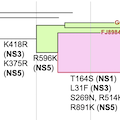Abstract
Dengue virus (DENV) is a global health threat, causing repeated epidemics throughout the tropical world. While low herd immunity levels to any one of the four antigenic types of DENV predispose populations to outbreaks, viral genetic determinants that confer greater fitness for epidemic spread is an important but poorly understood contributor of dengue outbreaks. Here we report that positive epistasis between the coding and noncoding regions of the viral genome combined to elicit an epidemiologic fitness phenotype associated with the 1994 DENV2 outbreak in Puerto Rico. We found that five amino acid substitutions in the NS5 protein reduced viral genomic RNA (gRNA) replication rate to achieve a more favorable and relatively more abundant subgenomic flavivirus RNA (sfRNA), a byproduct of host 5′-3′ exoribonuclease activity. The resulting increase in sfRNA relative to gRNA levels not only inhibited type I interferon (IFN) expression in infected cells through a previously described mechanism, but also enabled sfRNA to compete with gRNA for packaging into infectious particles. We suggest that delivery of sfRNA to new susceptible cells to inhibit type I IFN induction before gRNA replication and without the need for further de novo sfRNA synthesis could form a “preemptive strike” strategy against DENV.
